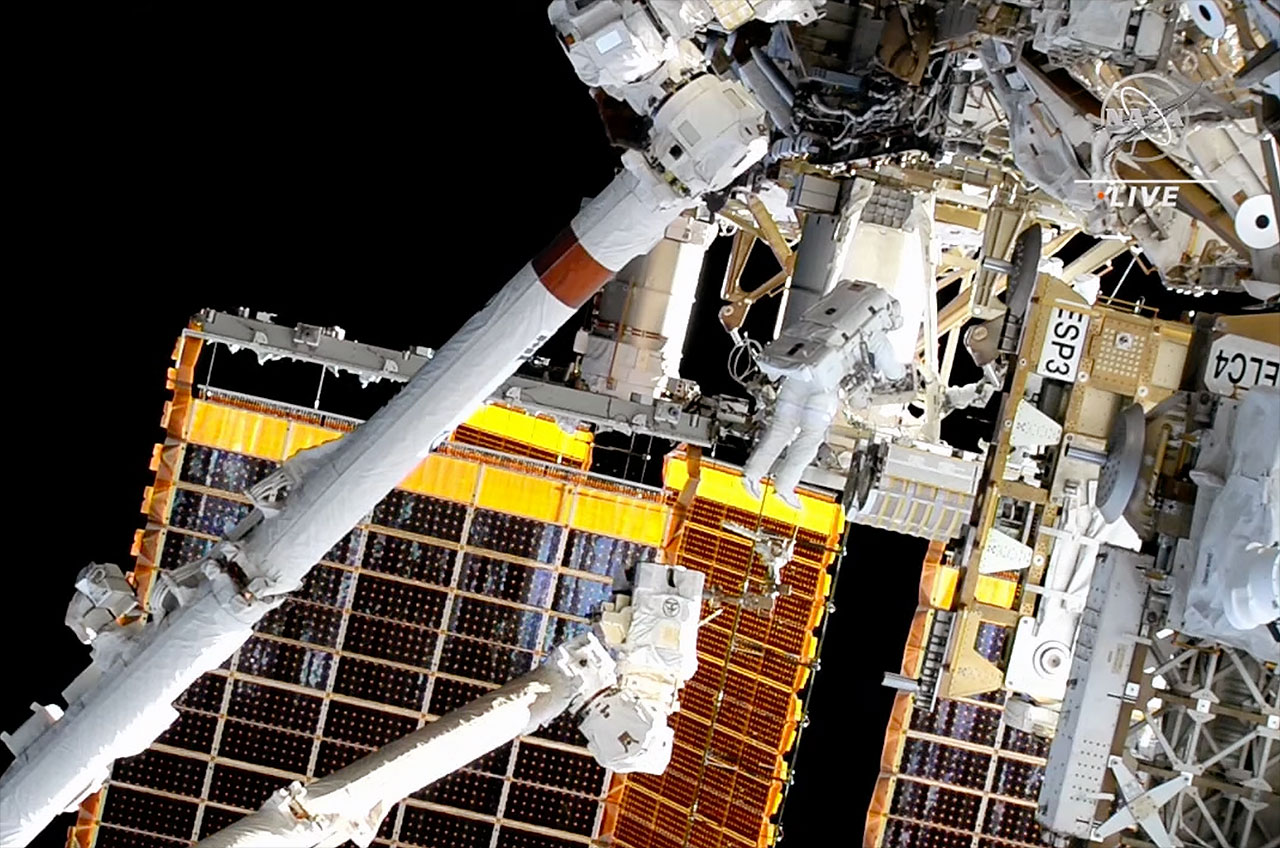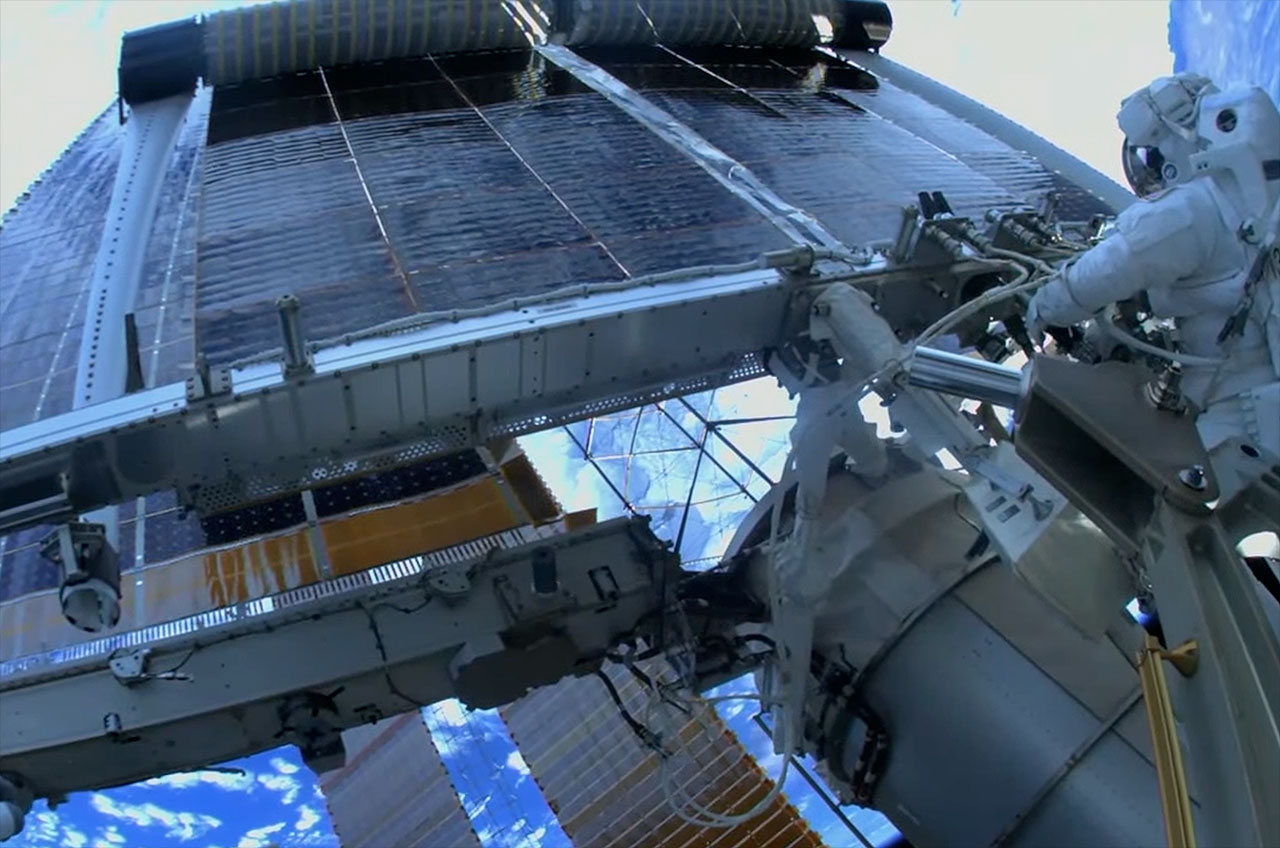NASA astronauts deploy 5th roll-out solar array on spacewalk outside space station (video)
Two NASA astronauts successfully installed and deployed a new solar array outside the International Space Station (ISS) during the latest in a series of spacewalks focused on upgrading the orbiting laboratory's power supply.
Stephen Bowen and Warren "Woody" Hoburg, crewmates on the station's current Expedition 69 mission, spent 6 hours and 3 minutes performing the extravehicular activity (EVA) on Friday (June 9). The two switched their spacesuits to battery power and began their exit from the U.S. Quest airlock at 9:25 a.m. EDT (1325 GMT).
As on past spacewalks (with different astronauts), Bowen and Hoburg first split ways, with Bowen heading out to where the new International Space Station Roll-Out Solar Array (iROSA) was temporary mounted. Hoburg, meanwhile, retrieved and installed a portable foot restraint on the end of the Canadarm2 robotic arm. He then boarded the arm, which was controlled by Emirati astronaut Sultan AlNeyadi from inside the space station.
Related: Spacewalks: How they work and major milestones
After Bowen released the iROSA from its pallet, Hoburg took hold of the 750-pound (340 kilograms) solar array to carry it to its installation mount on the starboard side of the station's backbone truss. Hoburg held onto the rolled up iROSA as AlNeyadi maneuvered the arm to move him and the hardware to the new location.
Making his own way over to the site, Bowen joined Hoburg in time to assist making a "soft dock" with the iROSA atop its mounting bracket, which was installed during an earlier EVA. The two astronauts then waited, as planned, for the space station to move into Earth's shadow, to attach the cables connecting the new iROSA with the station's legacy 1A power channel solar array.
The work was completed during a night pass, as the solar arrays do not generate electricity in the dark.
Breaking space news, the latest updates on rocket launches, skywatching events and more!
Bowen and Hoburg then released bolts to unfold the iROSA from its launch configuration and secured bolts holding the iROSA in place before proceeding with deploying the new array. With the release of two more bolts, the potential energy stored by the rolled-up carbon composite booms caused the iROSA to unroll on its own to its full length with no motor needed.
"It looks good. It looks like it is stretching out nicely, and everything seems to be lining up," said Bowen, describing the new array as it unrolled.
Like the four deployed before it, the new array is 60 feet long by 20 feet wide (18.2 meters by 6 meters). Fully extended, it shades a little more than half of the original 1A array. Each new IROSA produces more than 20 kilowatts of electricity, and once all the arrays are installed, they will enable a 30% increase in power production over the station's legacy panels, NASA officials have said.
Hoburg completed the work on the 1A power channel by releasing two bolts to tension the new array.
Having completed the primary task for the spacewalk almost an hour ahead of schedule, both spacewalkers were able to achieve some "get aheads" for their next EVA, scheduled for next week, to install the sixth iROSA on the IB power channel. Bowen and Hoburg released bolts to free beams holding the next array on its pallet and retrieved a piece of foreign object debris located on the rolled up array.
The two astronauts reentered Quest and re-pressurization began, marking the end of the 87th spacewalk from the U.S. airlock at 3:28 p.m. EDT (1928 GMT).
The spacewalk was Hoburg's first and Bowen's ninth. Bowen has now spent a total of 60 hours and 22 minutes on EVA, ranking him fifth in the world for the most time working in the vacuum of space.
This was the seventh spacewalk for the year and the 264th dedicated to the assembly and maintenance of the International Space Station since 1998.

Robert Pearlman is a space historian, journalist and the founder and editor of collectSPACE.com, a daily news publication and community devoted to space history with a particular focus on how and where space exploration intersects with pop culture. Pearlman is also a contributing writer for Space.com and co-author of "Space Stations: The Art, Science, and Reality of Working in Space” published by Smithsonian Books in 2018.
In 2009, he was inducted into the U.S. Space Camp Hall of Fame in Huntsville, Alabama. In 2021, he was honored by the American Astronautical Society with the Ordway Award for Sustained Excellence in Spaceflight History. In 2023, the National Space Club Florida Committee recognized Pearlman with the Kolcum News and Communications Award for excellence in telling the space story along the Space Coast and throughout the world.



